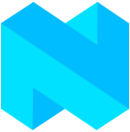Nodal is a web server for Node.js that was built with the sole purpose of making the developer's life easier.
Boasting its own opinionated, explicit, idiomatic and highly-extensible full-service framework, Nodal takes care of all of the hard decisions for you and your team. This allows you to focus on creating an effective product in a short timespan while minimizing technical debt.
Nodal projects are ready to deploy to Heroku right out of the box, so you can have your website live in no time.
Check out the first Nodal Screencast here.
Nodal is built upon an ideology of a robust, scalable microservice architecture. It can deliver solutions for every part of your system. From a simple HTTP service that provides server-generated HTML, to an API Server, to a scaffold for building Single Page Applications, you can spin up a Nodal server for anything.
Nodal servers are not meant to be monoliths. They're meant to be modular and distinct. Ideally, you should only use a subset of Nodal's features per project, and have multiple Nodal projects that are loosely-coupled and interface with one another (branding webserver, API server, application server). You can read more about specific types of servers and where you'd use them, if you're interested.
Due to this modularity, Nodal should never feel restrictive. It is not a silver bullet. It is meant as an entry point into distributed, modern web architectures. Once you're familiar with building these sorts of systems, swap in or swap out Nodal wherever you please.
Getting started with Nodal is easy.
- Download and install the newest Node 5.x version from nodejs.org
- Open terminal, and type
sudo npm install nodal -g. - Using your terminal, visit your projects folder. Perhaps with
cd ~. - Run
nodal new. - Follow the on screen instructions, enter your new project directory and type
nodal s.
That's it! Your Nodal webserver is up and running.
Once Nodal is up and running, it's likely that you'll want to connect your project to a database. Nodal comes packaged with Migrations, a Query Composer and full PostgreSQL integration.
First you'll need to install PostgreSQL. OS X users, I recommend using Postgres.app for your development environment.
Once you've installed Postgres, make sure to run:
$ createuser postgres -s
To create a default postgres superuser with no password. (Default for Nodal's configuration.)
To begin using your database, start with:
$ nodal db:create
To create the database and then,
$ nodal db:prepare
To prepare for migrations.
From here, nodal db:migrate runs all pending migrations and nodal db:rollback
will roll back migrations, one at a time by default.
Nodal works best when you follow its ideology, and that means creating a new Nodal server to solve specific Problem Domains of your application and business.
The main three suggestions are Branding Server, API Server and Application Server.
This ideology is focused around a distributed, fault-tolerant, loosely-coupled systems designed where no single service is dependent upon any other one. If a junior developer accidentally brings down your Branding Server, for example, your API and Application still work perfectly.
This is your Google-able, SEO-indexed server for your product or service, containing your branding pages. Use Nodal's Templates and partials (using doT.js) to show your users server-generated HTML pages that serve as a great introduction to what you're showing off. If you need to grab live data from an API, send asynchronous non-blocking requests to your API Server.
Here's the controller for a sample index page:
class IndexController extends Nodal.Controller {
get() {
this.render(
this.app.template('index.html').generate(
this.params,
{
test: this.params.query.test,
name: 'My Nodal Application'
}
)
);
}
}Create an API server using Nodal's Models, PostgreSQL integration, built-in JSON API formatting, and Query Composer (ORM). Bi-directional migrations are packaged with Nodal, meaning you can maintain the integrity of your data. User (including password) and OAuth AccessToken models and controllers are pre-built for you and can be added easily to your project.
Packaged with Nodal are workers, scheduling modules, and much more for all of your data needs.
We can look at what an API Controller might look like for, say, blog posts:
class BlogPostsController extends Nodal.Controller {
index() {
BlogPost.query()
.join('user')
.join('comments')
.where(this.params.query)
.end((err, blogPosts) => {
this.respond(err || blogPosts);
});
}
show() {
BlogPost.find(params.id, (err, blogPost) => this.respond(err || blogPost));
}
create() {
BlogPost.create(params.body.data, (err, blogPost) => this.respond(err || blogPost));
}
update() {
BlogPost.update(params.id, params.body.data, (err, blogPost) => this.respond(err || blogPost));
}
destroy() {
BlogPost.destroy(params.id, (err, blogPost) => this.respond(err || blogPost));
}
}Use Nodal's Initializers to specify asset compilation for your single page web applications. Use modules like nodal-angular or roll your own. Interface with your Nodal API server dynamically to provide a great user experience.
You'll be able to learn more about Nodal at nodaljs.com.
Nodal has the majority of its important methods fully documented inline, in the codebase. You will be able to find this translated and prettified at nodaljs.com.
Nodal is under active development and maintained by Keith Horwood.
Contributors welcome!
Follow me on Twitter, @keithwhor
Fork me on GitHub, keithwhor
Thanks for checking out Nodal!
